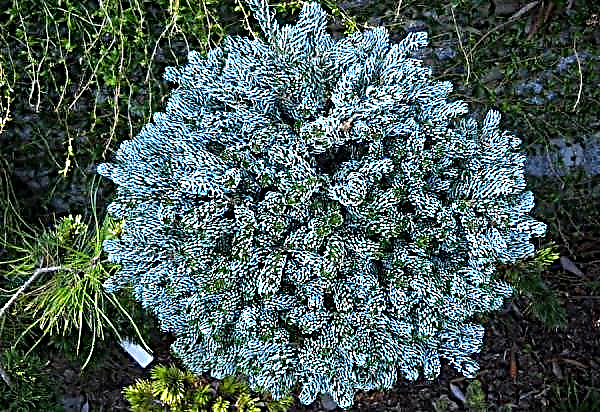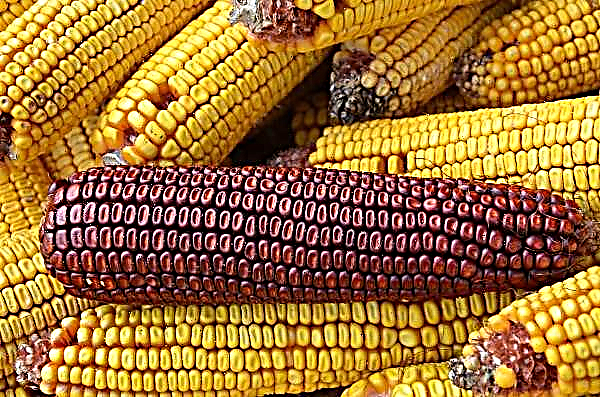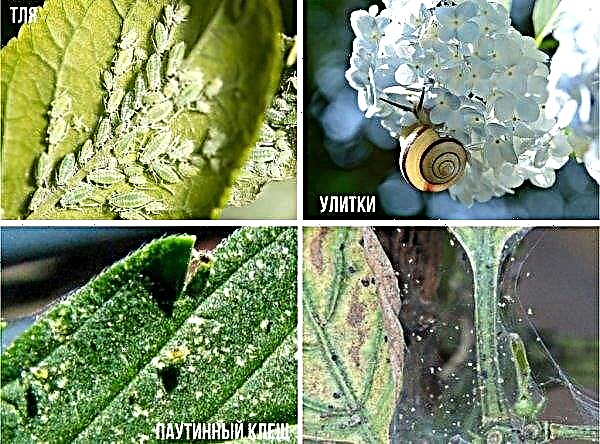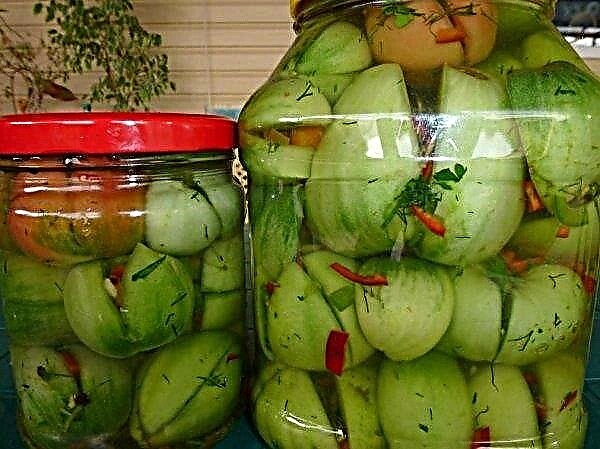Copper wire is not only a building and electrical material, but also an effective tool to combat plant diseases and stimulate their growth. For example, this property is actively used by gardeners to combat late blight of tomatoes. How this happens and why - will be described in more detail later in the article.
Description of the disease
Phytophthora is a fungus whose spores are extremely tenacious and can survive significant temperature fluctuations and negative values on a thermometer even in fragments of plant stems and roots. Active reproduction occurs already at a temperature of +10 ° C, with rainfall or as a result of irrigation, spores penetrate the soil, infecting tubers of healthy plants, or are carried by the wind. Scientists have about 40 species of this fungal disease. At the end of the 20th century, there was only one strain of this fungus, which died at low temperatures. To date, 2 strains are known, when crossed, fungal spores are not afraid of cold weather and can survive in the remains of unburned tops.

Phytophthora has a detrimental effect, mainly on the solanaceous family, most often suffer from it:
- Tomatoes
- potatoes;
- pepper;
- eggplant.
Important! Affected by late blight fruits are not eaten. Seeds of infected tomatoes cannot be used for sowing the next crop.
Reasons for the appearance
The causative agent of late blight is fungal spores, which begin to multiply actively, getting into a favorable environment.
There are a number of reasons that can contribute to infection:
- long wet weather with rains;
- a sharp drop in temperature and its significant fluctuations at different times of the day;
- large planting of tomatoes;
- increased concentration of calcareous component in the soil;
- violation of ventilation in the conditions of growing tomatoes in greenhouses.
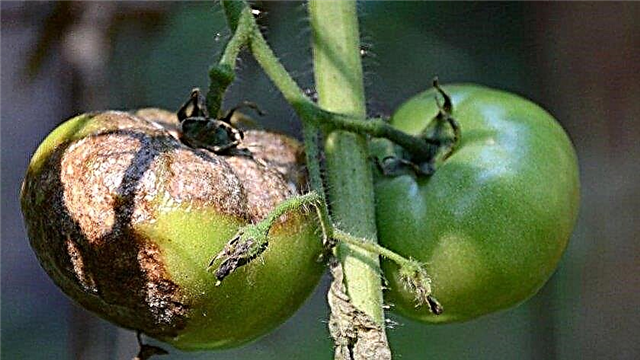
The appearance of the first signs often occurs at the end of the summer period - the beginning of autumn, when the difference between the day and night temperatures is significant, and in the mornings on the bushes you can notice a plentiful dew drop, which does not have time to dry out, because the soil is no longer warming up enough to dry out excess moisture.
Signs
The occurrence of late blight on the bushes can be recognized by the following characteristic signs:
- the appearance of brown spots along the edge of the foliage. In the process of the development of the disease, they begin to grow and merge, covering the entire surface of the leaf;
- the formation of stripes of dark color on the stem of the bush;
- the appearance of spots of silver and brown flowers on the fruits;
- the appearance of a velvety, white coating on the leaves, which has an oily texture to the touch;
- drying of foliage and primordia of fruits, their falling.
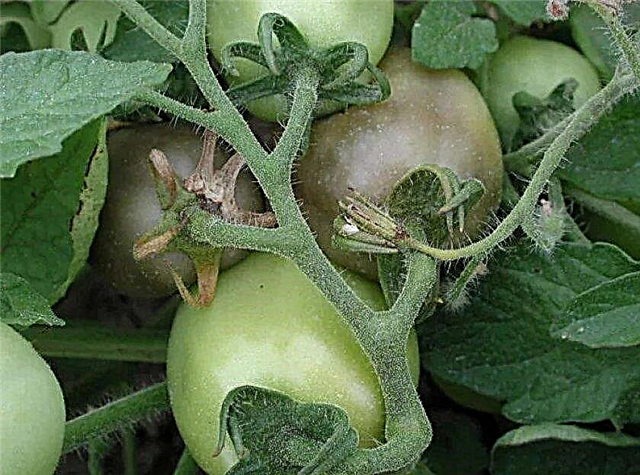
The effect of copper on tomatoes
Copper is an important element that is part of plants and takes part in many biological processes that occur in them:
- internal metabolism;
- photosynthesis;
- It is a component of enzymes that participate in redox reactions, accelerating them.
The copper content in plants is insignificant, and its lack can lead to such consequences:
- diseases;
- stunted growth;
- yield reduction;
- curl leaves;
- weak root system;
- lack of flowering;
- in some cases, even to their death.
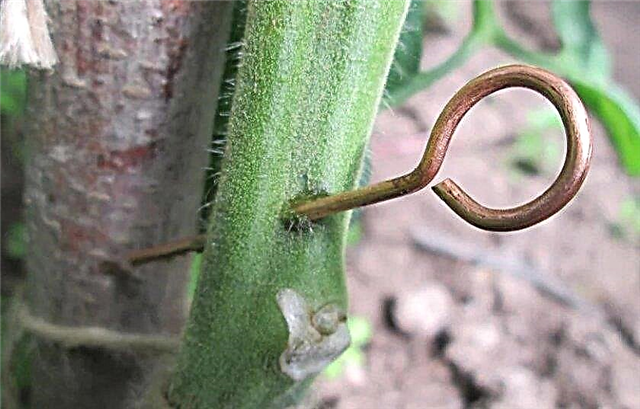
That is why the use of copper is extremely important in the cultivation of tomatoes. It is used not only as top dressing, but also as an instrument of physical action on phytophthora fungal spores. For this, experienced gardeners use copper wire, piercing the plant stem with it. The circulation of nutrients in the plant occurs from the rhizome to the apex, the internal juice washes the copper wire, and an interaction reaction occurs. High copper photosynthesis effectively counteracts late blight.
Benefit
- The positive effect of copper is:
- effects on the synthesis of chlorophyll, preservation and stabilization of its level;
- increases the production of ascorbic acid, carbohydrates, proteins and fats;
- active in the process of rhizome and stem formation;
- accelerates the growth and formation of fruits;
- stimulates the absorption of ammonia;
- participates in nitrogen metabolism.
Harm
- An excess amount of copper negatively affects the development of the plant, which can manifest itself in the form of:
- yellowing of veins on leaf blades and their death;
- the development of the root system with a large number of lateral roots painted in brown, which leads to a slowdown in growth;
- lack of iron in plant nutrition.
How to use copper wire
In the fight against late blight on tomato bushes, experienced gardeners are actively using copper wire.
There are several ways to use it, however, all of them, first of all, involve the following procedures:
- thorough cleaning of the plastic shell;
- sandpaper processing.
Copper wire is used:Did you know? In the tops of tomato bushes are toxins that can be used to destroy pests and some diseases. To do this, you need to prepare a decoction of recycled stems and leaves, which, first of all, will help get rid of aphids and caterpillars, as well as scare away insects.
- For winding rhizome seedlingsbefore it is transplanted into the open ground. For this, you may need a wire with a diameter of 0.5 mm, a length of 50 cm.
- As copper fertilizerputting a piece of copper wire or a small plate under the tomato bush. At each irrigation, the metal will react with the soil, enriching it.
- Stick a piece of wire into the stemso that copper, under the influence of plant juice, spreads throughout its structure.

The latter method is the most popular, so you should talk about it in more detail:
- A small piece of copper wire is inserted into the soil 2-1.5 weeks before disembarkation or after the same period of time after. This will allow the plant to get a little used to the effects of copper.
- If the puncture with copper wire occurs on seedlings that have not yet been planted, then this should occur 1 cm below the first sheet on the stem from the rhizome. A piece of metal should be no more than 4 cm long.
- If seedlings have already been planted in the ground and adapted in the soil, the wire is inserted into the stem 4–5 cm from the earthed up earth or in rainy weather at a distance of 9–10 cm.
Important! The ends of the wire, which will be used to combat late blight, cannot be wrapped around the trunk, as this will impede the growth of the plant. The best solution is to bend its tips down.
Additional Tips for Treating a Disease
In order to protect the tomato crop from late blight, in addition to copper wire, you can use such special and folk remedies:
- prophylactically to process and feed bushes with immunomodulatory solutions;
- use fungicides and special chemicals for processing from late blight;
- cover the bushes with film or non-woven material, which will protect them from abundant morning dew;
- use kefir solutionby diluting 1 liter of fermented milk product in 10 liters of water. This method involves weekly treatment of the bushes from the moment the ovary appears;
- yeast can also help get rid of late blight at the initial stage. For this, 100 g of fresh baker's yeast must be diluted in 10 l of water;
- garlic tincture is able to effectively counteract the development of fungal disease. To do this, you need to take 1.5 cups of finely chopped garlic and insist on 10 l of water for a day, after which 2 g of potassium permanganate is added to the solution. You can use the tool every two weeks;
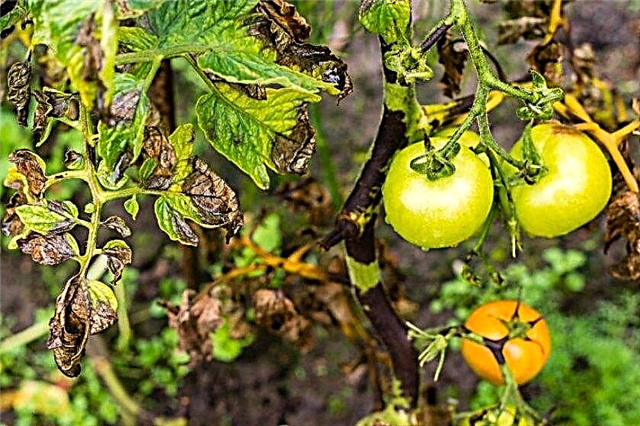
- a salt film on the foliage prevents the spread of late blight. To do this, spray the bush with a solution by adding 250 g of salt to 10 l of water;
- ash can also be an excellent tool in the control and prevention of late blight in tomatoes. To prepare the solution, use 5 l of ash per 10 l of water, mix well and let it brew, stirring occasionally. Then water is added to the solution until a total volume of 30 l is obtained, and soap or remnants are added to the solution, which will allow the resulting mixture to adhere well to the stems and leaves of the bush;
Did you know? The hormone of "happiness" - serotonin, which is found in tomatoes in significant quantities is able to cheer up and relieve spleen. To do this, it is better to opt for the fruits of pink varieties.
- iodine solution is often used as an antifungal and antimicrobial agent. One of the recipes is that you need to add 1 liter of low fat milk to 9 liters of water, and then add 20 drops of iodine there;
- boron solution is also used, which is prepared according to the following recipe: 10 g of boric acid are dissolved in 10 l of hot water, and then 30 drops of iodine are added.
The use of copper wire for prevention
Prevention is the main way to effectively resist late blight. It must necessarily include the following points:
- proper seating of vegetable crops and the necessary care for the bushes;
- sufficient, but not excessive watering and proper shelter;
- the use of necessary nutrition to maintain good plant immunity;
- preventive spraying with chemical and folk remedies that have an effect on late blight.
Video: Copper wire in the fight against late blight
One of the most effective methods of prevention is the use of copper. The minimum required supply of this substance has already been laid down by nature in the plant’s body itself, but if its quantity decreases, the plant begins to hurt, the process of photosynthesis and normal breathing is disrupted, the death of leaves and stems begins, and the plant dies. Artificial addition of copper to the plant’s diet can improve the process of its vital activity.
Timely and regular prevention will help get rid of phytophthora, and copper plates or wire will become an effective weapon in this fight and will help increase the plant's immunity, accelerate its growth and fertility.
Network user reviews
Yes, this is a good method of preventing late blight. I conducted an experiment several years ago — part of the bushes already affected by late blight, left for “survival”, and in others I inserted copper wire into the trunks. The difference was noticeable, in the second case, the disease was not instantaneous, but it came to naught, and the fruits were all whole. Many even had to be pulled out of the bushes without wire. So it’s worth doing this painstaking work, but probably not like me, when the late blight spread, but immediately, when a threat occurs, which can be easily judged by the weather.
http://www.bolshoyvopros.ru/questions/1487571-ogorod-stoit-li-v-stvol-pomidornogo-kusta-vstavljat-mednuju-provoloku.html#answer4369730





